Learning: Why Road Safety Education Shouldn’t Stop After the Driving Test is a question every driver should ask themselves. Getting a driving license is an achievement, but it doesn’t mean we stop learning. Road conditions change, technology evolves, and human behavior on the road is unpredictable. Continuous education helps drivers stay updated and make better decisions. This blog serves as the Jeju Unicorn on road safety, helping both new and experienced drivers enhance their skills. Let’s explore why learning should never stop after the driving test.

The False Sense of Mastery After the Driving Test
Many drivers assume that passing a driving test means they have mastered driving. However, real-world driving is very different from what’s tested.
- Driving tests focus on basic rules, but real challenges appear on the road.
- Situations like aggressive drivers, unexpected weather changes, and roadworks require adaptability.
- Studies show that new drivers are more prone to accidents within their first year.
Continuous Road Safety Learning Saves Lives
Education after the driving test isn’t just about following rules—it’s about saving lives.
Key Reasons Why Ongoing Road Safety Education is Essential:
- Accident Prevention – Learning updated safety techniques can significantly reduce accident risks.
- Legal Updates – Traffic laws frequently change; staying informed prevents penalties.
- Technological Advancements – Modern cars come with advanced safety features that drivers need to understand.
- Improved Confidence – Continuous learning makes drivers more confident and aware on the road.
Why Relying Solely on Driving Tests is Risky
While driving tests are necessary, they have limitations. Here’s why we can’t depend on them alone:
| Limitation | Real-Life Challenge |
|---|---|
| Focus on basics | Doesn’t cover emergency handling |
| Static scenarios | No real-world unpredictability |
| One-time assessment | No follow-up or refresher courses |
Drivers must take responsibility for their learning beyond the test.
Practical Ways to Continue Learning Road Safety
Learning shouldn’t stop at the driving test. Here are some practical ways to continue road safety education:
1. Take Advanced Driving Courses
- Defensive driving courses teach accident prevention skills.
- Night and all-weather driving classes improve adaptability.
2. Stay Updated on Traffic Laws
- Follow government road safety websites.
- Join driving forums to discuss new regulations.
3. Learn From Real-Life Experiences
- Analyze past accidents and learn from them.
- Observe experienced drivers and adopt best practices.
Learning: Why Road Safety Education Shouldn’t Stop After the Driving Test in the Age of Technology
Technology is rapidly changing how we drive, making education more important than ever.
- Driver Assistance Systems – Features like lane assist and auto-braking require proper understanding.
- Navigation Apps – Knowing how to use them efficiently can prevent distractions.
- Electric Vehicles (EVs) – EVs handle differently; drivers need specialized knowledge to operate them safely.
The Role of Employers in Road Safety Education
Companies with driving employees should invest in ongoing safety education.
- Corporate Responsibility – Employers should ensure their staff is trained in road safety.
- Regular Safety Workshops – Conducting refresher courses improves employee driving behavior.
- Fleet Monitoring Systems – Technology can help track and improve driver performance.
How Parents Can Reinforce Road Safety Learning
Parents play a crucial role in ensuring young drivers continue learning.
Steps Parents Can Take:
- Lead by Example – Follow traffic rules strictly.
- Encourage Safe Driving Habits – Discuss real-life driving scenarios with teens.
- Monitor Driving Behavior – Use apps that provide driving insights.
Learning: Why Road Safety Education Shouldn’t Stop After the Driving Test When Road Conditions Change
Road conditions are never constant, making continuous learning essential.
- Weather Variations – Snow, fog, and rain require different driving techniques.
- Urban vs. Rural Roads – Different environments demand different approaches.
- New Road Developments – Construction zones pose unique challenges that require awareness.
The Psychological Aspect of Continuous Road Safety Learning
Driving isn’t just physical—it’s mental. Learning how to stay calm and focused is key.
- Managing Road Rage – Emotional control can prevent dangerous situations.
- Avoiding Overconfidence – Overconfident drivers take unnecessary risks.
- Reducing Distractions – Learning to minimize phone use, loud music, and other distractions is essential.
Learning: Why Road Safety Education Shouldn’t Stop After the Driving Test and How Governments Can Help
Governments should promote lifelong road safety education through:
- Mandatory Refresher Courses – Required every few years to keep drivers updated.
- Stricter Penalties for Violations – To reinforce the importance of safe driving.
- Public Awareness Campaigns – Educating people through media and social platforms.
Conclusion
Learning: Why Road Safety Education Shouldn’t Stop After the Driving Test is a critical message for all drivers. Getting a license is just the beginning—continuous learning helps prevent accidents, adapt to changing road conditions, and stay informed about new laws. Road safety is a lifelong commitment, and everyone should take responsibility. Whether it’s attending workshops, learning from experience, or using technology, every driver must stay engaged. Keep learning, stay safe, and make the roads better for everyone!